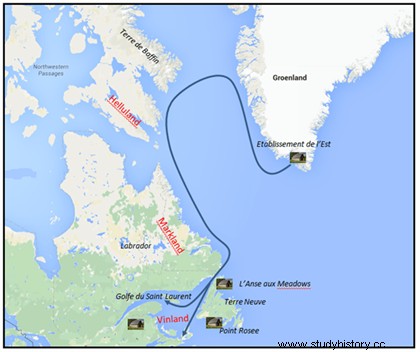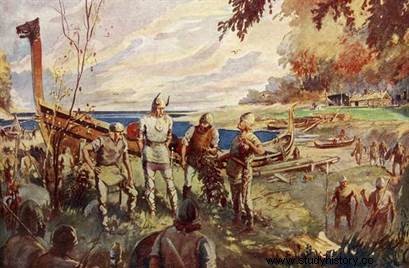 The Vikings , led by the explorer Leif Erikson, are considered today as the first Europeans to have discovered America, five hundred years before Christopher Columbus. Around the year 1000, Icelanders established in Greenland indeed approached the shores of North America, naming the lands they encountered Vinland. Two sagas report these facts:on the one hand the saga of Erik the Red and on the other hand the saga of the Greenlanders and Leif Erikson . Recent archaeological finds in Canada support these stories.
The Vikings , led by the explorer Leif Erikson, are considered today as the first Europeans to have discovered America, five hundred years before Christopher Columbus. Around the year 1000, Icelanders established in Greenland indeed approached the shores of North America, naming the lands they encountered Vinland. Two sagas report these facts:on the one hand the saga of Erik the Red and on the other hand the saga of the Greenlanders and Leif Erikson . Recent archaeological finds in Canada support these stories.
Discovery of America by the Vikings:archaeological research
In 1960, Anne Stine Ingstad and her husband Helge Ingstad discovered the Anse-aux-Meadows site at the northern tip of the island of Newfoundland. Seven excavation campaigns have uncovered the foundations of six houses with peat walls, two buried houses, one of which contains the remains of a forge, four boathouses and two cooking pits. The set is of Nordic type, similar to the Icelandic and Greenlandic establishments. The objects found - in particular a soapstone spindle wheel, a bone needle, a bronze pin, numerous nails used in the construction of boats - are dated with carbon 14 with a value of approximately 1000. Thus, the site of l'Anse-aux-Meadows is recognized as one of the sites of Norse settlements in the Americas, according to the Sagas.
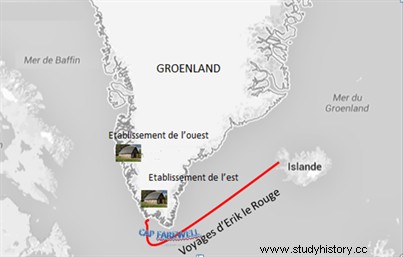 Lately, a second site, located much further south, has been updated. It is located at Pointe Rosée, at the end of Newfoundland at the mouth of the St. Lawrence River, near two bays suitable for anchoring boats. In June 2015, American Sarah Parcak, a researcher from the University of Alabama, using satellite surveys, spotted what appears to be the remains of earthen walls of a Viking building.
Lately, a second site, located much further south, has been updated. It is located at Pointe Rosée, at the end of Newfoundland at the mouth of the St. Lawrence River, near two bays suitable for anchoring boats. In June 2015, American Sarah Parcak, a researcher from the University of Alabama, using satellite surveys, spotted what appears to be the remains of earthen walls of a Viking building.
This technique for which this researcher was awarded has already enabled her to detect other ancient Egyptian and Roman sites. Excavations have been undertaken and they have revealed the traces of a hearth surrounded by a wall of grass, charcoal and iron residues mixed with peat, in short, a hearth for forging metal of a type common among the Vikings. Carbon 14 dating puts these traces back to around the years 1000 to 1300.
Two sagas, the Erik the Red saga and the Greenlanders saga tell of the Viking voyages to the Americas and in particular the discovery of these lands by Leif Erikson. These are the only sources historians have on this subject and their very nature makes what they report questionable. Moreover, they present great differences in their content. However, the discovery of the Anse-aux-Meadows site, to which may be added that of Point Rosee, tends to confirm what they relate.
Leif Erikson from the Greenlanders Saga
Leif Eríkson was born around 970, probably in Iceland. He is the son of Erik the Red (Eiríkr Þorvaldsson) a proud Viking with abundant red hair and Thjodhild. Originally from Norway, Erik grew up in Iceland where he emigrated with his father Þorvaldr Ásvaldsson, after he was banished for murder. As an adult, Erik is in turn banished from Iceland for three years for the same reasons as his father. He embarked and left for the North, eager to find lands that compatriots lost at sea had already described:he thus approached the coasts of Greenland and settled there in a verdant region free of ice.
The past three years, he returned to Iceland and convinced 500 compatriots to come and settle in the country he explored and which he himself called "Greenland “, that is to say “green land” because “he says that people would really want to go there if this country had a beautiful name” (Saga of Erik the Red, chapter 2). 21 boats leave, but only 14 of them manage to cross Cape Farewell. There, the meeting of warm currents (Gulf Stream) and cold currents (Greeland Current) causes turbulence and fog. Settlers create two settlements; "Western Settlements" and "Eastern Settlements".
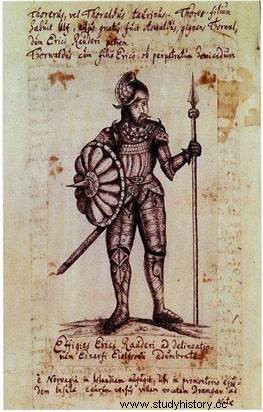 Leif Erikson grew up in Greenland where his father became one of the most important settlers. There he hears of the lands that a countryman named Bjarni Herjólfsson sighted around 986 when he was diverted west on his journey from Iceland to Greenland. Accompanied by 35 men, Leif goes on an exploration. He left the settlements in the East and headed west. He first encounters a land dominated by glaciers which he calls "Helluland", the country of the Flat Stones, then continuing south, he approaches a country with a sandy shore behind which rise tall trees. He calls this land “Markland”, the Land of Forests.
Leif Erikson grew up in Greenland where his father became one of the most important settlers. There he hears of the lands that a countryman named Bjarni Herjólfsson sighted around 986 when he was diverted west on his journey from Iceland to Greenland. Accompanied by 35 men, Leif goes on an exploration. He left the settlements in the East and headed west. He first encounters a land dominated by glaciers which he calls "Helluland", the country of the Flat Stones, then continuing south, he approaches a country with a sandy shore behind which rise tall trees. He calls this land “Markland”, the Land of Forests.
Biarne, having gone to Norway (c. 994), visited Erik Jarl, from whom he was well received. He made an account of trips where he had seen unknown lands. They found him not very curious not to have examined these countries better, and they reproached him for it. However, he was included in the number of courtiers of the Jarl. The following summer he returned to Greenland, where much was said about his discoveries. Leif, son of Erik Rauda of Brattahlid, went to find him and bought his ship from him. Having attached thirty-five companions, he begged his father to put himself at their head. Erik apologized for his age, which no longer allowed him, as in the past, to expose himself to cold and water; but he finally yielded to the entreaties of Leif, who represented to him that he had more happiness than any of the members of their family, and when all was ready he rode to the ship, which was nearly away.
But the horse stumbled, the rider fell to the ground and damaged his foot. He said on this occasion:“It is not in my destiny, I believe, to discover any country other than this; so we won't go any further together. So he returned to Brattahlid, while his son embarked with his thirty-five companions, among whom was a man surnamed Tyrker. Having set sail, they found the country that Biarne had seen. They dropped anchor, put a boat out to sea, and came ashore. Between the coast and the glaciers that rose farther inland, the ground was strewn with pebbles. There was no lawn, and the country was devoid of any kind of amenities. “But at least, says Leif, we didn't do like Biarne, who neglected to visit this land. I want to give it a name. I call it Helluland (rocky country). (Saga of the Greenlanders, translation remacle.org).
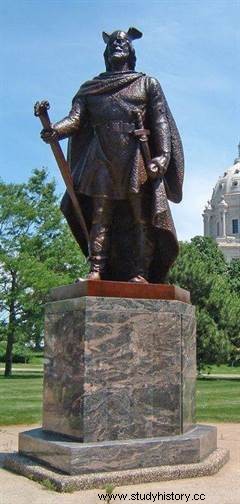 Leif Erikson still continues south along the coast and discovers a welcoming land. The air is mild, the river is full of salmon, the days are longer than in Greenland. Wild vines grow there. The country is referred to as "Vinland", which is often translated as "Land of the Vine". Leif and his men decide to settle in these places. They build houses in a place called “Leifsbúðir – Leif's barracks -” and two groups are formed:one is in charge of guarding the place, the other of carrying out excursions in the neighborhood. The men stay there for a few months, cut wood and harvest grapes. Then they leave and return to Greenland.
Leif Erikson still continues south along the coast and discovers a welcoming land. The air is mild, the river is full of salmon, the days are longer than in Greenland. Wild vines grow there. The country is referred to as "Vinland", which is often translated as "Land of the Vine". Leif and his men decide to settle in these places. They build houses in a place called “Leifsbúðir – Leif's barracks -” and two groups are formed:one is in charge of guarding the place, the other of carrying out excursions in the neighborhood. The men stay there for a few months, cut wood and harvest grapes. Then they leave and return to Greenland.
Having noticed dew on the grass, they tasted it and found it tastier than anything they knew. Having re-embarked, they navigated a narrow strait between the island and a promontory which jutted to the north, and which they turned as they headed west. The water was very low, and at the time of the ebb tide their vessel lay dry. They saw each other at a great distance from the sea; but they were in such a hurry to visit the land, that they did not have the patience to wait for the high tide to refloat their boat; they immediately went to the shore, towards the mouth of a river which issued from a lake. At high tide, they returned by boat to their ship, on which they sailed up the river and the lake. They anchored there, and having landed their belongings, they erected some huts.
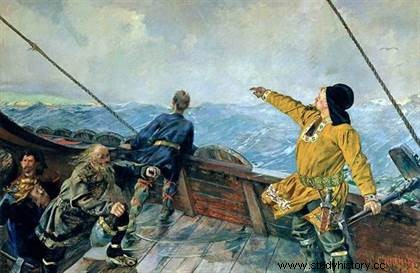 Then they decided to make preparations to spend the winter there and built a big house. In the river and the lake they found an abundance of salmon, the largest they had ever seen. The climate was so favorable that it would not have been necessary to feed the cattle in the barn during the winter. There was hardly any frost there, and the grass withered very little. The inequality of days and nights was less great there than in Iceland and Greenland, since the sun rose at half past seven and set at half past four on the shortest days. » (Saga of the Greenlanders, remacle.org translation) .
Then they decided to make preparations to spend the winter there and built a big house. In the river and the lake they found an abundance of salmon, the largest they had ever seen. The climate was so favorable that it would not have been necessary to feed the cattle in the barn during the winter. There was hardly any frost there, and the grass withered very little. The inequality of days and nights was less great there than in Iceland and Greenland, since the sun rose at half past seven and set at half past four on the shortest days. » (Saga of the Greenlanders, remacle.org translation) .
The Travels of Leif Erikson
Further shipments follow. The following year Leif Erikson's brother, Thorsvaldr, undertook a new journey and wintered twice in Leif's barracks. But, he is killed by the natives; his companions then return to Greenland; A year later, another son of Erik the Red, Thorsteinn, unsuccessfully attempted the trip; Thorfinn Karlsefni, who is secondly married to Thorsteinn's widow, undertakes a journey taking families and livestock with the aim of settling permanently. In the second winter, after a clash with the natives, the settlement was abandoned and everyone returned to Greenland.
In the saga of Erik the Red, it is Leif Erikson who plays the role of Bjarni Herjólfsson and sees the lands of the Americas as he is confused on his way to Greenland returning from Norway. The journey that leads to the location of the places named Helluland, Markland and Vinland is carried out by Thorfinn Karlsefni. Two bases are created, Straumfjord in the north which serves as a winter residence and Hóp further south which is a summer camp occupied only for two months during which wood and grapes are harvested. All the successive expeditions narrated in the saga of the Greenlanders are grouped together in a single great journey.
The confrontation with the natives
In either sagas, the first voyage is followed by attempts at more lasting settlement, with the explorers taking cattle with them. The settlers then find themselves confronted with an indigenous population they call “Skraelingjar” and who travel on the water using kayaks. The term "Skraelingjar" is pejorative, it designates weak, sickly, stunted beings. The Norwegian term "skroela" means weak, sick and the term "skral", weak, sickly. These natives are described as small, black, ugly men with horrible hair, large eyes and large faces.
Relations are initially peaceful; the natives offer furs and receive sheets and milk, because Thorfinn Karlsefni forbade giving arms. Then, it seems that these "Skraelingjar" take fright and they come back to attack. The violent confrontation then pushed the Greenlanders to abandon their bases.
It so happened that a bull, brought by Karlsefne, came out of the forest and began to bellow. This noise frightened the natives, who fled in their canoes and rowed south along the coast. They were not seen again for three whole weeks. But after this lapse of time, there came from the south a large number of Skralingar, mounted on boats whose march was as rapid as a Celtic torrent. They brandished poles against the sun and uttered high-pitched howls.
Seeing that the people of Karlsefne presented them with a red shield, they descended to the ground and ran to meet them. A fight ensued where the Skrselingar launched a hail of arrows, for they had ballistae. They raised at the end of a pole an enormous ball, which looked like a sheep's bladder and which was bluish. Thrown at Karlsefne's troops, it made such a noise as it fell that they were terrified and began to flee along the river, for it seemed to them that they were surrounded on all sides. They only stopped on rocks where they put up a vigorous resistance. (Saga of Erik the Red, translation remacle.org).
Vinland, a still mysterious place
Locate Vinland
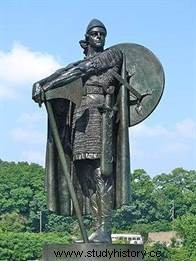 Baffin Island seems to correspond to the country Helluland and Labrador to the country called Markland. Vinland is more difficult to recognize, but it could be located somewhere between the right bank of the Saint Lawrence and Cape Cod. The researchers offer several hypotheses. Archaeologists have found traces of butternut trees on the Anse aux Meadows site. It is a tree that cannot grow at this latitude. Its northern limit of expansion is latitude 47, which corresponds to the region of the city of Miramichi and New Brunswick in Canada. It is also at this latitude that the wild vine can grow. By the way, salmon are only found in the rivers that are north of New York.
Baffin Island seems to correspond to the country Helluland and Labrador to the country called Markland. Vinland is more difficult to recognize, but it could be located somewhere between the right bank of the Saint Lawrence and Cape Cod. The researchers offer several hypotheses. Archaeologists have found traces of butternut trees on the Anse aux Meadows site. It is a tree that cannot grow at this latitude. Its northern limit of expansion is latitude 47, which corresponds to the region of the city of Miramichi and New Brunswick in Canada. It is also at this latitude that the wild vine can grow. By the way, salmon are only found in the rivers that are north of New York.
Thus, the northern base named Straumfjord could correspond to Anse aux Meadows and the Hóp site could find its place further south, near New Brunswick in Canada. Other research proposes to identify Vinland with the current site of Bay St Lawrence in the north of Cape Breton Island in Nova Scotia. Vinland thus corresponds to a large area located at the level of the Gulf of St. Lawrence.
The sites of Hóp and Straumfjord
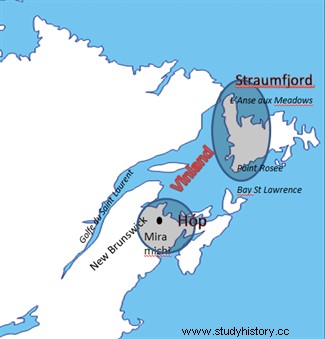 Regarding the "Skraelingjar", it is difficult to find which Indian or Inuit population they may correspond to . Several hypotheses have been put forward:the Beothuks, native inhabitants of Newfoundland, the Dorsets, Inuit of the North American Arctic or the Micmacs, Native American people of the northeast coast of America.
Regarding the "Skraelingjar", it is difficult to find which Indian or Inuit population they may correspond to . Several hypotheses have been put forward:the Beothuks, native inhabitants of Newfoundland, the Dorsets, Inuit of the North American Arctic or the Micmacs, Native American people of the northeast coast of America.
Finally, we should return to the term "Vinland" and its meaning. Vinland is mentioned for the first time around 1075 in the book “Descriptio insularum Aquilonis” (Description of the northern islands) written by the chronicler and geographer Adam of Bremen (1050, †1085). His information on the geography of the northern countries was brought to him by King Sven II of Denmark (1020, †1076), while he was staying at his court. Adam writes:"Besides, he also pointed out an island discovered by many sailors in this ocean, which is called Vinland, for the reason that the vines grow there by themselves, produce the best wine".
The meaning of the term Vinland given by Adam of Bremen is erroneous and it is due on his part to a misunderstanding of the Norse language, close, but different from the old Germanic that he speaks. "Wine" compounded with "land" in Old Norse means "fertile land", "land of the meadows" while the term "wine" in Old German is actually linked to wine, hence the resulting transcription "land of the vine .
Map of Vinland
The map of Vinland is a map of the world which dates from the 15th century and which is kept in the Beinecke library at Yale. It has the particularity of showing lands considered unknown at that time, including an island called Vinlanda Insula, on which there is a large estuary which seems to correspond to that of the Saint Lawrence and a lake accessible by water which gives a representation from Hudson's Bay.
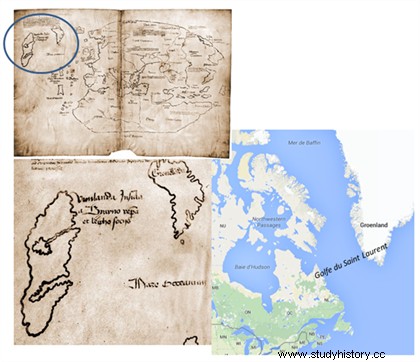 The authenticity of this map is much debated today. It was donated to the university in 1957 and was attached to an authentic Historia Tartorarum codex. The contents, the ink and the paper of the card have been the subject of increasingly detailed analyses. The parchment was dated by carbon 14 and the result gives a date between 1423 and 1445. The analysis of the ink carried out in 1974 made it possible to detect the presence of titanium dioxide, a substance that chemistry has only been able to produce since the 1920s. But this substance is only present in trace amounts and could come from external contamination. The plot is composed of an almost erased black line above a yellowish line. The iron ink used in most medieval manuscripts does indeed yellow over time. But the black pigment identified here is carbon, not iron. The yellow line would therefore not result from aging, but from fraud.
The authenticity of this map is much debated today. It was donated to the university in 1957 and was attached to an authentic Historia Tartorarum codex. The contents, the ink and the paper of the card have been the subject of increasingly detailed analyses. The parchment was dated by carbon 14 and the result gives a date between 1423 and 1445. The analysis of the ink carried out in 1974 made it possible to detect the presence of titanium dioxide, a substance that chemistry has only been able to produce since the 1920s. But this substance is only present in trace amounts and could come from external contamination. The plot is composed of an almost erased black line above a yellowish line. The iron ink used in most medieval manuscripts does indeed yellow over time. But the black pigment identified here is carbon, not iron. The yellow line would therefore not result from aging, but from fraud.
Celebrating Leif Erikson's journey
In 2000, the millennium of Leif Erikson's journey was celebrated. On this occasion, the Islendingur, a boat built by the Gunnar Marel Eggertsson shipyard as a replica of a Viking ship, set sail. It left Reykjavik on Iceland's National Day, June 17, did stopover at Búðardalur for the feast of Erik the Red, then he doubled Cape Farewell and continued on his way until reaching Anse aux Meadows on July 28th. The Islendingur is a replica of the Gokstad boat, discovered in 1882 and dated to the 870s. Its construction required 18 tons of wood and 5000 nails. It is 22.5 meters long and 5 meters wide. Its draft is 1.7 meters.
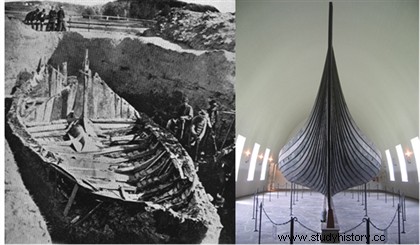 The Gokstad Ship excavations in 1880 and the ship on display at the Viking Ship Museum, Oslo, Norway. In addition, every October 9, America commemorates “Leif Erikson Day”, three days before “Columbus Day”. The date chosen corresponds to that of the entry into the port of New York. The date chosen corresponds to that of the entry into the port of New York of the Restoration ship carrying on board the first group of Norwegian immigrants in America.
The Gokstad Ship excavations in 1880 and the ship on display at the Viking Ship Museum, Oslo, Norway. In addition, every October 9, America commemorates “Leif Erikson Day”, three days before “Columbus Day”. The date chosen corresponds to that of the entry into the port of New York. The date chosen corresponds to that of the entry into the port of New York of the Restoration ship carrying on board the first group of Norwegian immigrants in America.
Bibliography
- Europe of the Vikings, collective work. Daoulas Abbey, Hoëbeke, 2004.
- Island, Greenland, Vinland, Essay on the movement of the Scandinavians to the west in the Middle Ages, Régis Boyer, Les Editions Arkhê, 2011.
- The Vikings, Régis Boyer, Tempus, 2015.
Sources
- La Saga d'Eirik le Rouge followed by Saga de Greenlandais, translated from Icelandic and annotated by Régis Boyer, Folio pocket.

